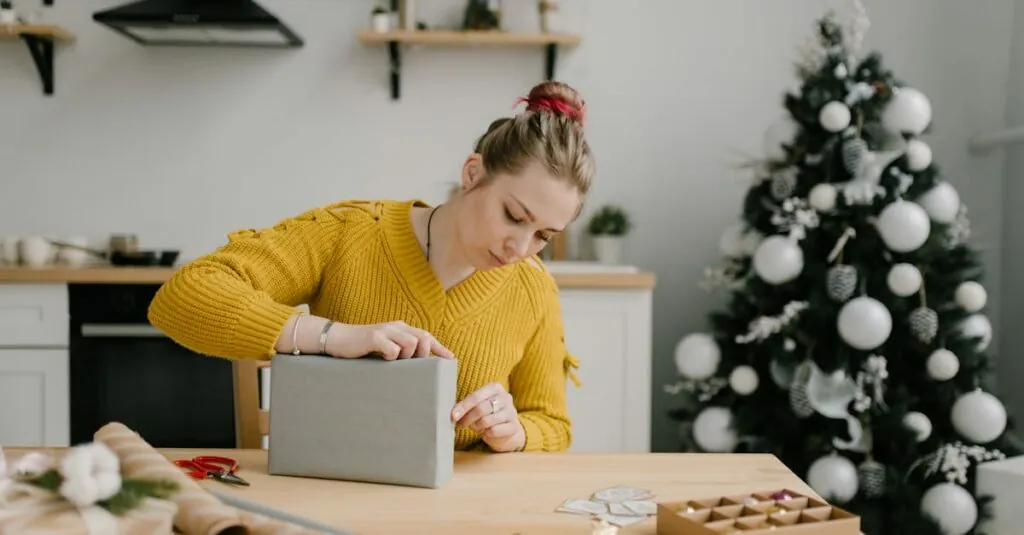Table of Contents
ToggleTired of wrestling with unruly rolls of plastic wrap and aluminum foil every time you need to cover leftovers? You’re not alone! The kitchen can quickly turn into a chaotic battleground of clingy wraps and tangled bags. But fear not—there’s a solution that not only restores order but also adds a touch of charm to your culinary space.
Overview of DIY Kitchen Wrap Organizers
DIY kitchen wrap organizers offer practical solutions for managing plastic wrap, aluminum foil, and parchment paper. These organizers keep wraps within reach while minimizing clutter in cabinets and drawers. Various designs cater to individual preferences, making it easy to find a style that fits any kitchen.
Constructing a kitchen wrap organizer requires basic materials such as wood, cardboard, or repurposed items. A simple wooden box can serve as a functional organizer with compartments for different wrap types. Similarly, utilizing wall-mounted racks maximizes vertical space, allowing for easy access and visibility.
Crafting customized labels enhances organization. Labels indicate where each wrap resides, preventing confusion during food prep. An additional consideration is the incorporation of a dispenser feature, enabling a smooth and controlled cut of wraps when needed.
Installation methods vary, with options for mounting to walls or placing on countertops. Wall-mounted solutions keep counters clear while providing quick access to wraps. Countertop units work well in compact kitchens where space is limited.
Effective DIY organizers not only serve a practical purpose but also elevate kitchen aesthetics. By choosing colors and finishes that match existing decor, organizers can blend seamlessly into the kitchen environment. Thus, a simple DIY project transforms a chaotic kitchen into an organized and visually appealing space.
Benefits of Having a Kitchen Wrap Organizer
Organizing kitchen wrap improves functionality and enhances the cooking experience. Various advantages arise from having a well-designed kitchen wrap organizer.
Improved Accessibility
Accessing plastic wrap, aluminum foil, and parchment paper becomes seamless with a dedicated organizer. Items sit within easy reach, making cooking more efficient. No longer will one struggle to unroll tangled materials. A well-structured system allows quick identification of each wrap type. Efficiency in meal preparation increases as time spent searching decreases. Clear labeling on containers speeds up access even further. Users appreciate simple pull-out dispensers that facilitate straight cuts and hassle-free usage.
Space-Saving Solutions
Maximizing kitchen space is essential for effective organization. DIY kitchen wrap organizers provide compact solutions tailored to fit any kitchen size. Wall-mounted racks free up valuable counter space while keeping wraps readily available. Innovative designs cater to different kitchen layouts, ensuring each organizer complements its environment. Simple wooden boxes can also serve as decorative elements when properly styled. Storing wraps vertically helps utilize limited storage areas effectively. This approach not only keeps materials contained but also promotes an orderly kitchen atmosphere.
Materials Needed for a DIY Kitchen Wrap Organizer
Creating a DIY kitchen wrap organizer requires a few essential materials that are often easily found in most homes. These materials can make the project straightforward and enjoyable.
Common Household Items
Cardboard is a versatile option for crafting organizers. It provides a sturdy base that can be shaped as needed. Wooden boxes, often found in storage or craft supplies, serve as an excellent foundation for a more durable design. Tin cans can be repurposed into stylish containers for rolls. Adhesive hooks attach the organizer to a wall, preserving counter space and allowing easy access to wraps. Clear plastic containers keep smaller items neatly stored, avoiding clutter.
Specialized Tools
A utility knife cuts materials with precision, ensuring clean edges and optimal fit. Measuring tape ensures accuracy when sizing the organizer. A hot glue gun provides a strong bond for assembling various components, reinforcing stability. Sandpaper smooths out rough edges on wooden pieces, enhancing safety. Paint or stain adds a customized finish to the organizer, allowing it to blend seamlessly with kitchen decor. Lastly, a level ensures that wall-mounted organizers align properly, preventing any uneven displays.
Step-by-Step Guide to Creating Your Own Kitchen Wrap Organizer
Creating a kitchen wrap organizer requires thoughtful planning and assembly of materials. Follow these steps to craft an efficient and visually appealing solution.
Planning Your Design
Start by assessing available kitchen space. Determine the best location for the organizer, whether countertop or wall-mounted. Choose a design that fits aesthetic preferences and functional needs. Consider including sections for plastic wrap, aluminum foil, and parchment paper. An effective layout enhances accessibility while maintaining a neat appearance. Measure each roll’s dimensions to ensure the organizer accommodates all materials. Sketch a design to visualize the layout before collecting materials.
Assembling the Components
Gather all necessary components for assembly. Use sturdy materials like wood or cardboard as the base. Prepare the workspace by laying out tools, including a utility knife and a hot glue gun. Cut the materials to the desired dimensions based on your design. Attach sections using hot glue, making sure they align correctly. Utilize adhesive hooks to secure the organizer to the wall, keeping counters clear. Sand edges for a polished finish, then paint or stain to match kitchen décor. Ensure all components fit snugly and function properly, resulting in a practical kitchen wrap organizer.
Creative Ideas and Designs
Exploring various designs can enhance the functionality of kitchen wrap organizers. These creative ideas cater to different kitchen styles while addressing common storage challenges.
Vertical Storage Options
Vertical storage maximizes space effectively. Using wall-mounted racks keeps plastic wrap and aluminum foil within reach. These organizers often feature multiple tiers, allowing for the separation of materials. Clear containers create a visually appealing display for each product type. When installed in the right spots, designs can add charm to the kitchen while decluttering counters. Incorporating hooks for additional items like scissors enhances usability. Durable materials ensure longevity, making this option both practical and stylish.
Drawer Inserts and Solutions
Drawer inserts provide another organizational alternative. Customizable dividers fit snugly into kitchen drawers, enabling tight storage of wraps. These solutions protect materials from damage while maintaining easy access. Consider using adjustable compartments for accommodating various roll sizes, as this flexibility suits diverse kitchen needs. A tray specifically for foil, plastic wrap, and parchment paper streamlines the cooking process. Simple labeling displays contents quickly, saving valuable time during meal prep. Selecting moisture-resistant materials prevents wear and tear, ensuring the organizer remains functional over time.
Creating a DIY kitchen wrap organizer offers a practical and stylish solution to the common clutter of plastic wrap and aluminum foil. By investing time in this project, one can transform a chaotic kitchen into an organized haven that enhances both functionality and aesthetics.
With various designs available, individuals can tailor their organizers to fit their specific needs and kitchen decor. The use of simple materials and tools makes it accessible for anyone to undertake this project.
Ultimately, a well-crafted kitchen wrap organizer not only streamlines meal prep but also elevates the overall cooking experience. Embracing this DIY approach can lead to a more efficient and enjoyable kitchen environment.




